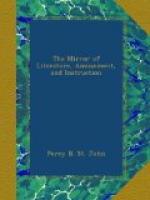Many native birds of prey have also been the subjects of unremitting persecution. The eagles, larger hawks, and ravens, have disappeared from the more cultivated districts. The haunts of the mallard, the snipe, the redshank, and the bittern, have been drained equally with the summer dwellings of the lapwing and the curlew. But these species still linger in some portion of the British isles; whereas the large capercailzies, or wood grouse, formerly natives of the pine forests of Ireland and Scotland, have been destroyed within the last fifty years. The egret and the crane, which appear to have been formerly very common in Scotland, are now only occasional visitants.
The bustard (Otis tarda,) observes Graves in his British Ornithology, “was formerly seen in the downs and heaths of various parts of our island, in flocks of forty or fifty birds; whereas it is now a circumstance of rare occurrence to meet with a single individual.” Bewick also remarks, “that they were formerly more common in this island than at present; they are now found only in the open counties of the south and east, in the plains of Wiltshire, Dorsetshire, and some parts of Yorkshire.” In the few years that have elapsed since Bewick wrote, this bird has entirely disappeared from Wiltshire and Dorsetshire.
These changes, we may observe, are derived from very imperfect memorials, and relate only to the larger and more conspicuous animals inhabiting a small spot on the globe; but they cannot fail to exalt our conception of the enormous revolutions which, in the course of several thousand years, the whole human species must have effected.
The kangaroo and the emu are retreating rapidly before the progress of colonization in Australia; and it scarcely admits of doubt, that the general cultivation of that country must lead to the extirpation of both. The most striking example of the loss, even within the last two centuries, of a remarkable species, is that of the dodo—a bird first seen by the Dutch when they landed on the Isle of France, at that time uninhabited, immediately after the discovery of the passage to the East Indies by the Cape of Good Hope. It was of a large size and singular form; its wings short, like those of an ostrich, and wholly incapable of sustaining its heavy body even for a short flight. In its general appearance it differed from the ostrich, cassowary, or any known bird.




